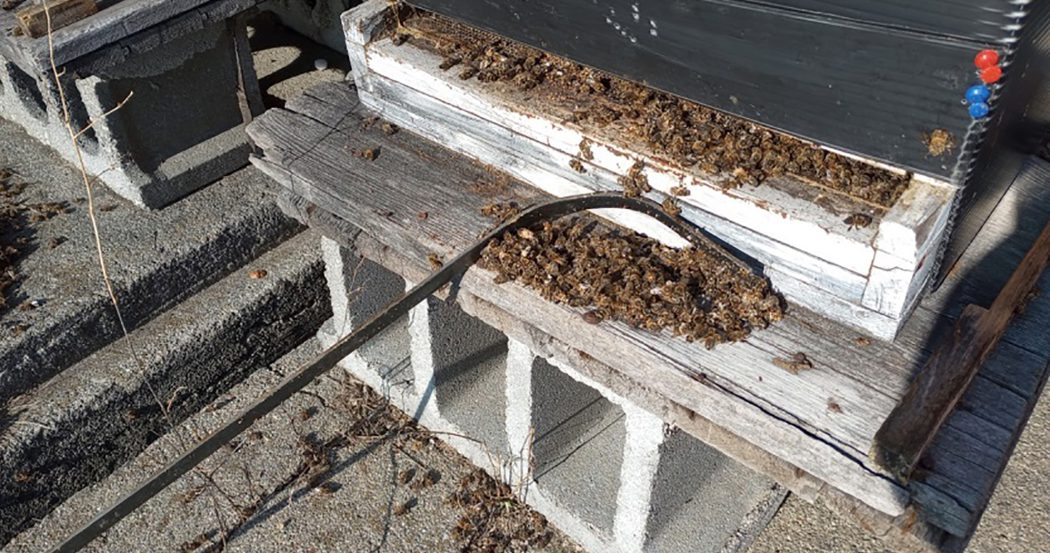Weather as a Factor in Beekeeping
New(ish) Beekeeper Column
By: Richard Wahl
We all know that one of the greater challenges in beekeeping is shepherding bees through our variable northern Winters. But what other weather factors should we consider when we are planning our beehive inspections, splits, mite control or feeding regimens?
In my experiences with beekeeping, I have come to rely on signals from nature and the variable weather patterns in my own surrounding environment rather than reliance on specific calendar dates that follow the same schedule year after year. So in this article, I will relate some of the clues and weather events that signal the appropriate time to take certain actions that have resulted in my success in getting at least one hive through every Winter for the past thirteen years. My greatest result occurred several years ago with nine hives going into Winter and those nine hives successfully surviving through the following Summer. This result allowed me to sell a few nucleus hives (nucs), raise a few more queens and take another step toward being a self-sustaining beekeeper.
As the Year Starts
At the beginning of the year, shortly after Christmas, is when I briefly open hives to add a cane sugar food supplement to the hive. It seems that every so often around the Christmas/New Year’s holidays there is a day or two that gets above 45°F (7°C) that allow for both cleansing flights and the insertion of extra food supplies. There are various ways to supply additional food resources including hard candy boards, sugar patties or granulated sugar over newspaper. I hesitate adding any sugar source earlier than late December. Any form of cane sugar is harder for the bees to digest and if they decide to tap into the additional hard sugar source in the Fall, it can possibly result in a form of dysentery. Dysentery is often the result of bees not being able to leave the hive for cleansing flights and finding it necessary to relieve themselves in the hive. The February and March time frames are when most hives are lost over Winter due to a lack of food resources.
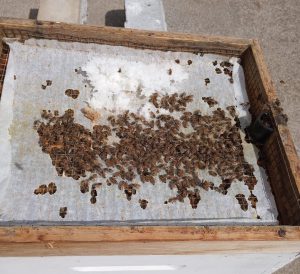
Winter sugar over parchment paper is nearly used up, the remains of a partial pollen patty at lower left of sugar.
Another Winter task is that every other month or so I will also use a bent ½ inch metal bar to clean out any dead bees from the bottom board. Once temperatures only occasionally drop below freezing at night, I will also remove my insulation sleeves that cover all but the bottom and top entrances to the hives. Some of my fellow beekeepers use blanket insulation and also remove them when temps begin to only erratically fall below freezing at night.
My next clue is the budding of maple trees in my yard. In some years, I have seen white pollen brought into hives in very early February; possibly from pussy willow shrubs, but not of sufficient quantity to support the needs of potential new larva. If one does see pollen being brought into the hive, this is a clue that the hive is most likely healthy and the queen has started to lay eggs, although in very small quantities this early in the year. In late March or early April there is one of a dozen maples in my yard that is always first to have the buds pop open. On a warm, sunny day, standing under the tree, it sounds like you are standing in a beehive. I use this as my signal to check the cane sugar supply once again and add a partial pollen patty to each hive.
The next pollen/nectar flow will not occur until a month later, in late April or early May. If they gather enough pollen from maples and other sources they will not use much of the pollen patty. But if rainy, cold weather precludes much pollen collection they may use most, or all, of the supplied patty and it may even need to be replaced before the dandelion bloom.
Heavy dandelion bloom is the next signal I use to know that Spring flowers and the dandelions are providing the first nectar flow. This is also my signal to do my first deep hive inspection and commence with any splits I may wish to do. Moving frames around, even if exactly replaced before dandelion bloom, can disrupt the hive in such a way that the cluster does not reform to provide the needed warmth for new eggs and larva resulting in the loss of the hive.
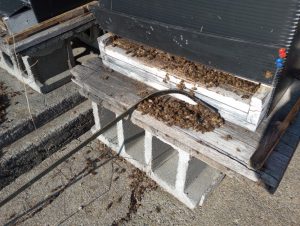
Bent metal bar used to clean out bottom board in Winter.
Opening a hive has a different meaning than inspecting a hive. Up to this point, I have only opened the top of hives to add sugar or pollen patties, while inspecting means to quickly examine each frame as it is removed and replaced or substituted if doing a split. The methodology of splits was covered in the April issue so I will not repeat my split techniques here. This is also the time where I will clean off the bottom board and remove excess old or pollen saturated frames.
Once May arrives, the beekeeping season gets into full swing here in SE Michigan. It is a good time to do the first mite check and initiate treatment, if called for. It is suggested that for the first few months of beekeeping the new beekeeper check hives once a week to every ten days. This is also a good recommendation for any new hives or nucs that have been started in order to monitor their progress. These do not have to be deep hive inspections looking at every frame. Often starting an inspection by pulling a frame or two from one side until eggs/larva are spotted is enough to see the hive is functioning well with an adequate queen without ever seeing the queen or looking at every single frame. As your comfort level and knowledge increases, hives may not need to be inspected for a month or more if things look normal with bees coming and going. Bees that are bringing in some pollen is a good sign there is a laying queen and larva to be fed.
Weather Affects Flying Time
Since beginning beekeeping, I find I keep a much closer watch of weather forecasts to determine the best times to work with my hives dependent on weather. As the Summer flowers start blossoming and nectar flows get into full swing, weather is the key factor in how much time bees can be flying and making collections of nectar, water, pollen or propolis. Any new splits or weaker hives can benefit from a feeding of one to one sugar syrup and an initial mite treatment if needed. I like to use a single Hopguard strip in five frame starter nucs just as a precaution. From this point on through the Summer, it is a matter of periodically checking hives to be sure the queen is laying, mite loads do not become excessive and no inherent diseases occur. When all but one or two frames in the top most super are drawn with comb and filled with brood or nectar and honey it is time to add another super. I prefer to keep my bee’s brood chamber in two ten-frame deeps with a queen excluder under any honey supers that are continually added through the Summer. I know of area beekeepers that work with eight frame medium supers and use three supers as their brood chamber with equal success. If I were to start over again, I would most likely choose the eight frame triple supers due to the weight factor of a ten frame deep super when full.
Taking weather into consideration, there are factors that come into play when the bees will be less agitated when doing an inspection. It is generally recommended that inspections be done on days when the outside temperature is above 55°F (13°C). On a warm, sunny day, most of the foragers will be out of the hive. If there is a front moving in or it is rainy out, the bees seem to be able to sense this and will be more agitated. Likewise, cloudy or windy days are not optimal times for inspections. The time of day that works the best seems to be between 11:00 a.m. and 3:00 p.m., although on nice Summer days that are longer, inspections can stretch into the late afternoon or early evenings.
When opening a hive, listen to the noise of the bees. If it goes from a peaceful hum to a louder roar it may not be the best time for a deep inspection of all frames. I recall helping a new beekeeper several years ago who had a work schedule that allowed for inspections to only occur on weekends. Several months of rainy or windy weather made it quite difficult to inspect during optimal weather which made for a more difficult beekeeping Summer. The hobby beekeeper with other employment challenges may find it difficult to find optimal overlaps between good weather and their free time to inspect hives.
Most of my reading and research indicates that mite checks are recommended about every month to month and half with the most critical time being August through September. This is when the mite population is exploding just as the bee population begins to decrease in preparation for Winter. Mite population control is without question the current most important part of beekeeping to insure hive survival over the coming Winter. When doing splits, I insert drone frames which forces me to get into new hives in less than 24 days for their removal. This assumes drone comb has been drawn, capped and drone brood is present. Mites prefer drone brood due to the slightly longer 24 day period it takes for drones to emerge. Removing drone frames prior to 24 days precludes a mite explosion as drones emerge from cells. When mite counts warrant treatment, I follow with a formic treatment in late June or early July followed by another treatment in late August or early September and finally one or two oxalic acid dribbles in October and late November if needed.
Harvesting Honey
Fully capped frames of honey can be taken any time of the beekeeping Summer/Fall season. I have taken honey from remaining Spring hives where the bees did not survive the Winter. If doing this, it is easiest if the honey frames are warmed and checked for any crystallization. Extracting frames that are partially crystallized can quickly plug up the filtration screens and make it very hard to strain the resultant honey. I have found it much easier to feed any unused overwintered frames back to the bees or use them in new hives or nuc splits. Bees from active hives will soon find frames that are set out some distance away from the apiary and will remove the surplus honey to existing honey supers. I have also had some luck with a partial super of near full frames placed over an inner cover that is on top of the upper most honey super allowing bees to clean out the excess frames of honey. During my first few years of beekeeping I only collected honey once in the Fall. This sometimes resulted in very tall hives as supers were added to give the bees more space.
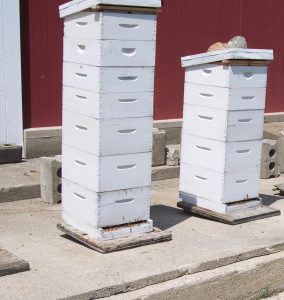
Three deeps and four full honey supers with a fifth added before Fall honey harvest reached over six feet and resulted in future harvests occurring twice a season.
I have since decided it is easier to make a harvest in late July followed by another in September. Any Fall flow is left for the bees to backfill the brood chamber for their Winter honey supply. If new nucs or hives are made from splits, those new starts may not produce any excess honey for the beekeeper in their first Summer. Taking too much honey from the bees in their first season is also a reason for Winter loss as this may result in Winter starvation.
The amount of nectar the bees collect that can be turned into honey is directly related to weather conditions. Continual rain and thunderstorms during a peak nectar flow can significantly cut down on flying time and wash away available flower nectar. Dearth periods where there is no rain for weeks also effects nectar availability, as the plants are using available ground moisture to sustain leaves and growth rather than producing pollen and nectar for flowers and seeds. Weather that is hotter than normal or nights that are colder than normal also impact the amount of nectar that plants produce. As the beekeeper learns to keep a close eye on weather and forecasts, they can better determine optimal times for inspections and if there will be a larger or smaller honey harvest.
Another aspect to consider is when to start nucs for overwintering. I have found that nucleus hives of four or five frames are best started in May or June but no later than the beginning of July. Four frame nucs started in those months may need a second or even a third story four-frame super added to make space for the increasing number of bees. The earlier the start, the more frames that may need to be added. In the following Spring, five frame nucs can be sold and excess frames used to begin new hives or nucs or simply used to increase ones hive count.
Fall Weather Clues
As Fall weather temperatures get cooler and daylight time gets shorter, the bees will be out foraging less and Fall nectar flows are sometimes questionable. Hives that have had their last honey harvest may benefit from Fall feeding of 2:1 sugar syrup. Any extracted honey supers can be placed over the inner cover and under the outer cover such that only the bees in the hive can clean out the honey supers for storage and reuse the following year. There is less chance of bees storing additional nectar/honey in the extracted honey super if it is placed on a different hive than that from which it was taken.
As the temperatures start to drop below 40°F (4.5°C) at night, it is time to combine hives or restrict hives to smaller spaces. This will also be when the Fall flowers such as golden rod and wild purple asters have passed their peak. If there are several weak hives they can be combined using the newspaper method between supers and pinching the weaker queen. Although, I have had very heavily populated hives come through the Winter in three deeps, I like to confine bees to only one or two ten-frame deeps as Winter approaches. New hives or swarms caught earlier in the Summer are usually best if confined to one ten-frame deep while established hives with a large population of bees may be better if allowed to have two deeps.
As stated earlier, August and September are critical months to keep mite counts under control. A day or two after doing a mite treatment, another test for mites is highly recommended to see if that treatment had an effect. If mite counts are still higher than recommended (3 per 100 in Fall) another treatment may be needed. High mite counts during these months are a strong indicator that the hive may not survive the Winter. As temperatures start to dip below freezing at night, it’s time to winterize the hives. I use a combination of a coroplast sleeve over the sides of the hive as well as Vivaldi style spacers for ventilation over the inner cover.
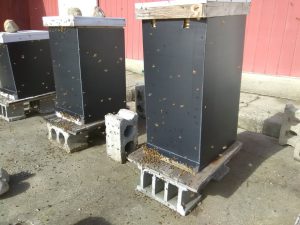
Coroplast plastic sleeves over hives.
There are other numerous ways to insulate a hive, such as using tarpaper or hive blankets if Winter temperatures can get very cold or are somewhat variable in your area. And this brings us full circle to the beginning of the next year.
As you become more experienced as a beekeeper, noting the changes in nature can lead to more efficient beekeeping dependent on your environments weather conditions rather than on calendar dates. I have found that keeping good notes has helped me improve from year to year. If you are not in a note taking mood, I have included a checkoff page (Download PDF) that can be copied and used as you inspect your hives. This is a slightly modified checklist obtained from a local beekeeper and used with permission from Jim Ford, who works with a Boy Scout troop to obtain various merit badges including beekeeping. Using clues from how weather patterns effect nature in your local environment can lead to a better beekeeping experience.




